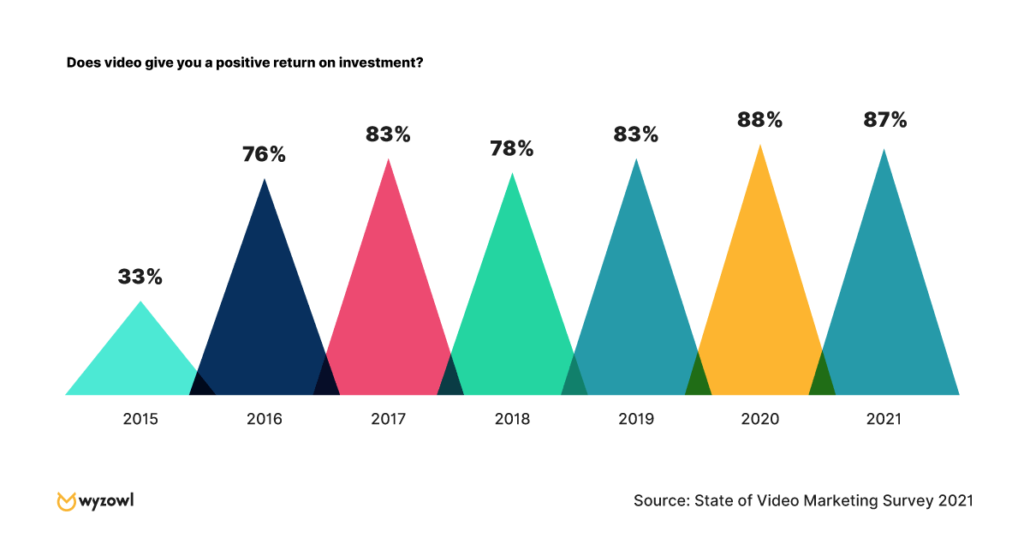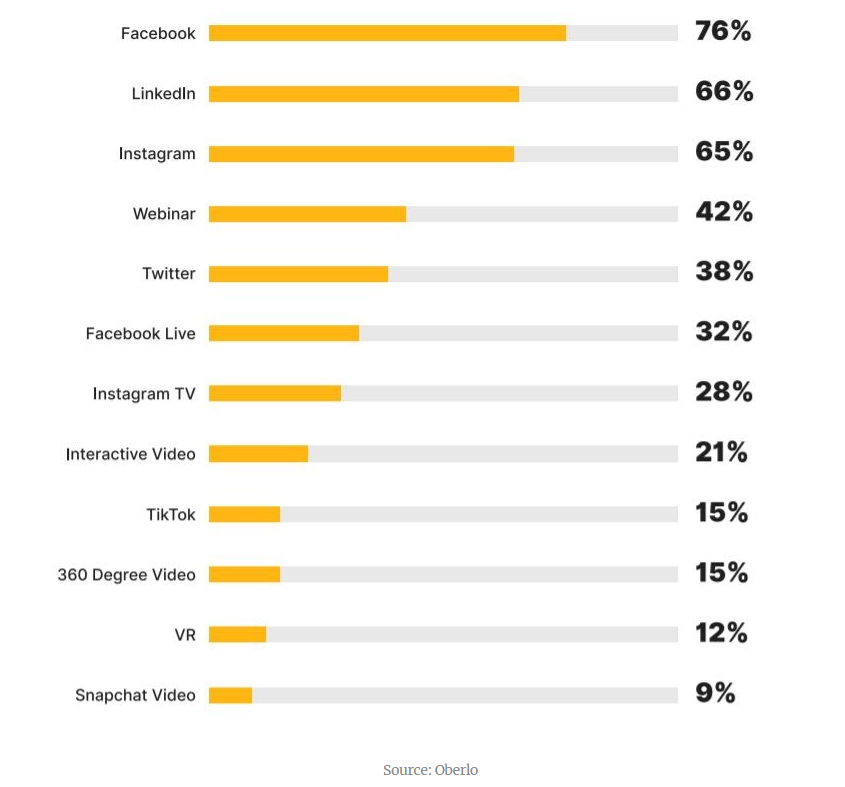Content marketing is no longer just writing blogs and whitepapers – it’s all about video for manufacturers. This post will help you discover why it’s more important than ever to develop a video marketing strategy that educates and entertains your audience.
Today’s modern B2B buyers are researching brands on channels like Google, YouTube, LinkedIn, email, and more before making a purchase decision. With more than 83% of adults consuming videos regularly, it’s no surprise that video can drive engagement and differentiate your products from competitors.
Manufacturers are now using video to show off their factory, connect with customers coast-to-coast, and demonstrate product features. Let’s dive deeper into how you can develop an effective video strategy.
Quick Takeaways:
- Video marketing is an effective way to connect and convert your buyers.
- There are several types of videos for manufacturers to create like product demos and testimonials.
- Video helps you boost your search engine rankings and drive more website visitors.
Why is Video Marketing Important for Manufacturers?
In 2020, partly due to the COVID-19 pandemic, 96% of consumers increased their video consumption and said they wanted to see more content from businesses. In fact, the average person watches 100 minutes per day online. With more eyes on content than ever before, it’s safe to say that video isn’t going away any time soon.
If you’re thinking that video content is only for B2C brands, you’re missing a massive opportunity to connect with your target audience and increase your bottom line. In fact, more than 80% of marketers state that using video as a marketing tool helps generate leads and increase ROI. Video marketing isn’t a one-off campaign, but instead a way to constantly build a relationship with your audience and educate them about your products.

Budgeting for Video Marketing Creation
Many manufacturers have lean marketing budgets that won’t accommodate big-scale video development. However, you can still develop quality videos with simple equipment and the right content direction.
For example, most modern smartphones have high-quality cameras, tripods cost roughly $20, and hundreds of free editing and production software options are available. While you can invest in lighting, advanced editing software, and other tools, it’s not always necessary.
Here are a few free or low-cost video tools to help you get started:
- VSDC Video Editor
- Adobe Spark or Premiere Pro
- Final Cut Pro
- Magisto
- Animoto
While you might want to jump in and buy the newest editing software or camera, it’s recommended to start small and scale.
5 Ways Manufacturers Can Create Powerful Video Content
Now that you’ve invested in video marketing, it’s time to start developing content for your channels. Here are a few ways manufacturers can leverage video:
1. About Us Video
An About Us video demonstrates everything from company history, values, and plans. It’s a great way to showcase your business’s personality and put a face to your brand name. You can feature this video on your homepage, social media channels, and anywhere else where potential customers could be researching your company.
Consider including the following highlights in your About Us video:
- Factory and office tour
- Message from the President or CEO
- Employee interviews
- History timeline
- Mission statement
It’s recommended to make a longer About Us video and then split it into multiple cuts to repurpose on different channels. For example, you can use the cuts in a welcome email nurture or as organic social content to help potential customers learn more about your business.

2. Customer Testimonial Videos
Since B2B businesses still rely on word-of-mouth recommendations and referrals, developing customer testimonial videos for manufacturers is critical. If you have a loyal customer or someone that you’ve helped grow, consider setting up a time to interview their experience.
In the interview, keep the focus on the customer and learn more about their business. You’ll also want to include their pain points and how your business helped them overcome a problem.
3. Product Demonstration or Tutorial Videos
Demonstrating your products or services is a great way to present your value to potential customers. Typical B2B buyers like to educate themselves before making a purchase, so creating a video tutorial will help explain complex or new products that you’re introducing to the industry.
Similarly, creating how-to videos with step-by-step instructions allow customers the chance to self-learn installations or common troubleshooting issues. You can house your videos in a resource library on your website for customers to view on their own time.
4. Industry Insights
If you want to differentiate from your competitors, you need to become a credible industry expert that your customers look to for valuable information. You can develop a weekly or monthly cadence to deliver industry insights to your audience on email and social media.
For example, on the first Monday of every month, you can produce “Monday Minutes” and review the latest trends and predictions. The key is to provide valuable information that your audience can’t get anywhere else.
5. Live Video
For brave manufacturers, many social platforms like Facebook and Instagram offer live video functionality. Since only 17% of businesses currently use live video, it’s a great opportunity to get ahead of the competition and show off your brand in an alternative format.
While it might be intimidating, live video allows you to show a more transparent view of your company and gets your audience involved in the fun. You can use video to go behind the scenes, launch a new product, or answer FAQs from your customers. To take it to another level, offer a live Q&A session that allows your customers to ask questions in real time.
Key Video Marketing for Manufacturers Best Practices
While you can create all the video marketing content you want, it won’t drive real results unless it reaches your target audience. Here are a few best practices to get the most out of your content:
Set the Right Goals
With any marketing strategy, setting goals, objectives, and KPIs is key to tracking your ROI, especially when it comes to developing videos for manufacturers. Without the right goals in place, you’ll waste resources, time, and budget making videos that may or may not drive new business.
What are you hoping to achieve with video marketing? Depending on your end objective, your content, audience, and budget could change. Here are a few objectives to consider:
- Improve customer education by positioning your brand as knowledgeable
- Increase brand awareness by communicating your business values or products
- Drive online engagement by earning likes, comments, followers, and shares
- Acquire more leads by driving traffic to your website or lead generation form
- Increase conversion rates from active customers by turning traffic into sales
- Nurture existing leads who aren’t ready to buy yet by developing trust
Once you formulate goals and develop content around them, it’s important to continuously track the analytics to measure video performance. By using unique tracking codes, you can analyze if your video influenced leads or customers to make purchases. You’ll also want to keep an eye on shares, likes, play rates, followers, and more.
Create a Personalized Experience
Delivering personalized experiences in the buyer’s journey is a powerful way to keep a lead’s attention on your brand. Why? Even B2B buyers like feeling special and personalizing an offer can increase click-through rates by 202%. Instead of creating 1:1 videos for every recipient, personalized video utilizes technology to customize the name, company name, logo, job title, etc. directly into the video.
You can embed personalized videos in:
- Email nurtures, product announcements, purchase celebrations, etc.
- Website landing pages after collecting form information or tracking cookies
- Sales enablement for an account-based marketing (ABM) strategy to target specific accounts
- Onboard new customers with personalized welcome videos
Get Ranked Higher in Search Results
Video content for manufacturers doesn’t just help you build connections, but it also boosts your ranking in search engine results pages (SERPs) with the right optimizations. Search engines are placing more value on video content with the explosion of video platforms and streaming services. While all videos can rank in the video tab on Google, it’s harder to rank in the universal search results.
The higher you rank in search results, the more likely your target audience will click-through to your website. Here are a few ways you can optimize your video content for search rankings:
- Choose the right video platform. If you’re focused on brand awareness, use YouTube or Vimeo. If it’s driving website traffic, host it on your site through a service like Wistia.
- Include a transcript for every video so search bots can index the content
- Create an attractive thumbnail image to capture the searcher’s attention
- Write a title and description with targeted keywords that your audiences actively search for
- Embed your best video first on your website before others because Google only crawls one video per page
- Don’t include the video on multiple pages to avoid competing against yourself
Impress Buyers with Impactful Video Marketing Content
Video marketing is an excellent tool for manufacturers to drive website traffic, promote announcements, and create broader brand awareness. While it may seem intimidating, it’s important to start with your basics: set goals, develop a content strategy, and monitor performance. From there, develop a customized video experience that can delight and convert customers effectively.
Get your video marketing strategy started and optimized with Shanahan Strategy Inc.

